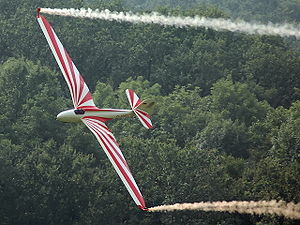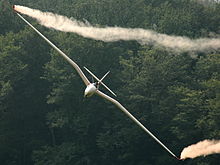- DFS Habicht
-
Habicht Christopher Zahn's Habicht replica Role Aerobatic sailplane Manufacturer DFS Designer Hans Jacobs First flight 1936 The DFS Habicht (German: "Hawk") was designed in 1936 by Hans Jacobs as an unlimited aerobatic sailplane, with support provided by the Deutsche-Forschungsanstalt für Segelflug. Four planes were made available for the Olympic Games of 1936, where the evolutions of the Habicht over and literally inside the Olympic stadium enthralled spectators.
The flight qualities of the Habicht were praised by pilots including Hanna Reitsch. It participated in many airshows abroad before the war, including the 1938 National Air Races in Cleveland, Ohio.
Modified versions of the Habicht, dubbed the Stummel Habicht ("Stumpy Hawk") were used to train pilots to land the Messerschmitt Me 163 rocket-powered fighter. The Me 163 was designed to use its entire load of fuel to reach combat altitude and then return to the ground as a glider. However, the landing speed of around 200 km/h (125 mph) posed a special challenge for pilots. Trainees therefore began on a Stummel Habicht on which the original Habicht's 13.6-metre (44 ft 7 in) gull wings had been replaced with straight wings of 8-metre (26 ft 3 in) span, and then progressed to another version with a 6-metre (19 ft 8 in) span.
Few Habichts survived the Second World War. There is one machine, flown by famous French aerobatic pilot Marcel Doret, in the Musée de l'Air in Paris. Another, with the registration D-8002, flew in Southern Germany until it was destroyed by the collapse of the hangar where it was stored. Apart from these genuine examples, Türk Hava Kurumu manufactured six reverse-engineered copies of the Habicht as the THK-3 in 1945-46.
After a long and patient research to recover the design documentation, Josef Kurz and other members of the Oldtimer Segelflugclub Wasserkuppe built an all-new Habicht. After an extended exhibition career, this exemplar registered also as D-8002 flies from the Wasserkuppe club's airfield.
Another airworthy Habicht was built by the Zahn family and first flew in 2001. Since then, at the hands of pilot Christoph Zahn, it has provided aerobatics demonstrations at numerous air shows.
Contents
Operators
- Austrian Air Force (1927-1938)
Specifications
General characteristics
- Crew: One pilot
- Length: 6.58 m (21 ft 7 in)
- Wingspan: 13.60 m (44 ft 7 in)
- Wing area: 15.8 m2 (170 ft2)
- Aspect ratio: 11.7
- Empty weight: 250 kg (550 lb)
- Gross weight: 350 kg (770 lb)
Performance
- Maximum speed: 250 km/h (160 mph)
- Maximum glide ratio: 21
- Rate of sink: 0.8 m/s (160 ft/min)
References
- Höntsch, Hannes (February 1997). "Schönhagen und das letzte Aufgebot". Flieger Revue.
External links
Aircraft produced by the Deutsche Forschungsanstalt für Segelflug Aircraft produced by Türk Hava Kurumu THK-1 • THK-2 • THK-3 • THK-4 • THK-5 • THK-6 • THK-7 • THK-8 • THK-9 • THK-10 • THK-11 • THK-12 • THK-13 • THK-14 • THK-15 • THK-16
Lists relating to aviation General Aircraft (manufacturers) · Aircraft engines (manufacturers) · Airlines (defunct) · Airports · Civil authorities · Museums · Registration prefixes · Rotorcraft (manufacturers) · TimelineMilitary Accidents/incidents Records Categories:- German sailplanes 1930–1939
- DFS aircraft
- Glider aircraft
- Gull-wing aircraft
Wikimedia Foundation. 2010.


